University Nursing Case Study: Mr. Wilson's Bilateral Pneumonia
VerifiedAdded on 2022/08/09
|11
|2905
|78
Case Study
AI Summary
This case study examines Mr. Roger Wilson, a 32-year-old gym instructor diagnosed with bilateral pneumonia. The assignment delves into the pathophysiology of the condition, explaining how the infection affects the lungs and causes symptoms like shortness of breath, fever, and chest pain. It focuses on the pharmacological interventions, including IV benzylpenicillin, Doxycycline, and Salbutamol (Ventolin), detailing their mechanisms of action, administration, and effects on the patient. The study also discusses the relevant symptoms, such as malodorous sputum, shortness of breath, and fever, linking them to the underlying infection and Mr. Wilson's history of asthma. The analysis provides a comprehensive overview of the disease, treatment strategies, and the patient's response, offering valuable insights into the management of pneumonia.
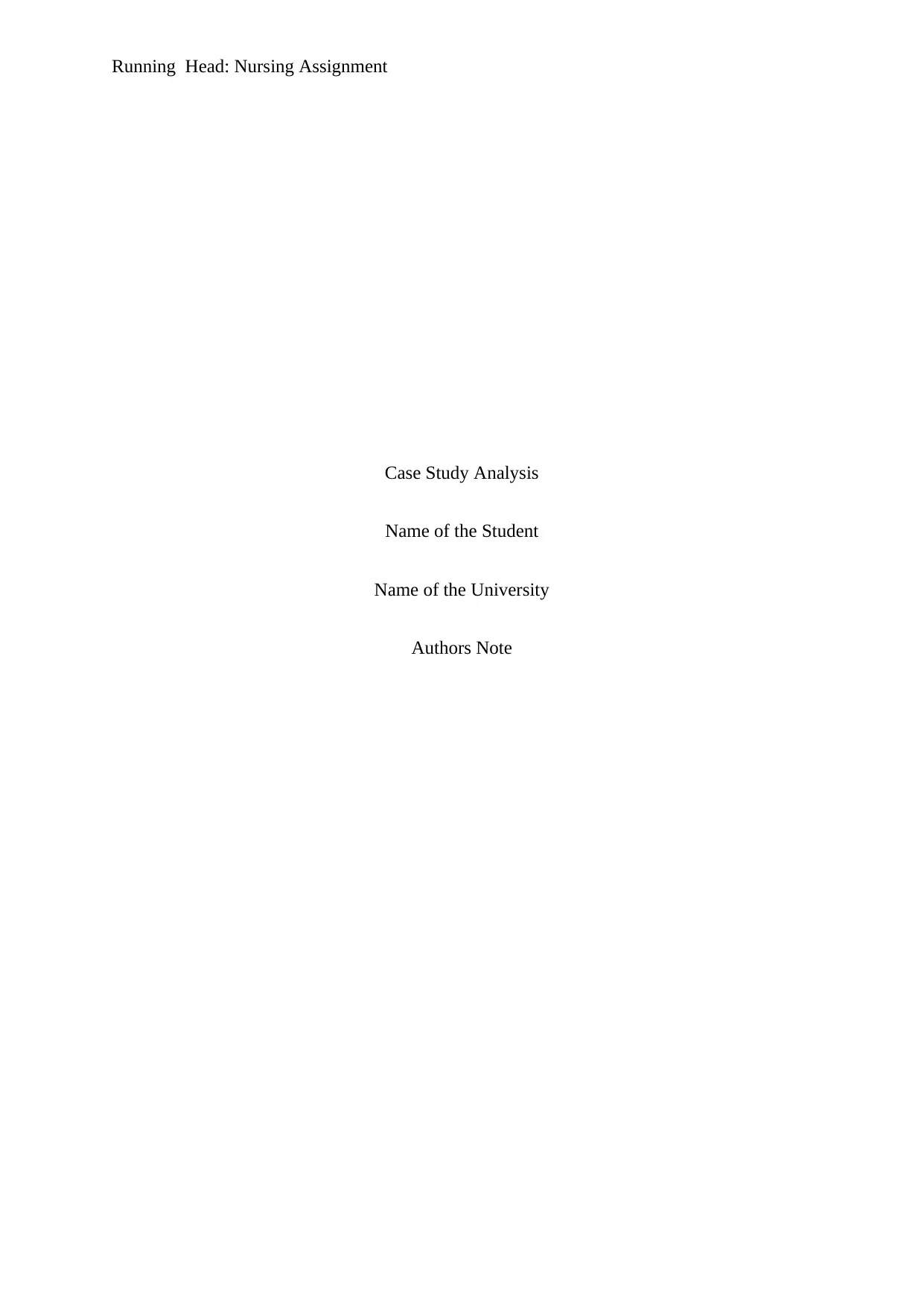
Running Head: Nursing Assignment
Case Study Analysis
Name of the Student
Name of the University
Authors Note
Case Study Analysis
Name of the Student
Name of the University
Authors Note
Paraphrase This Document
Need a fresh take? Get an instant paraphrase of this document with our AI Paraphraser
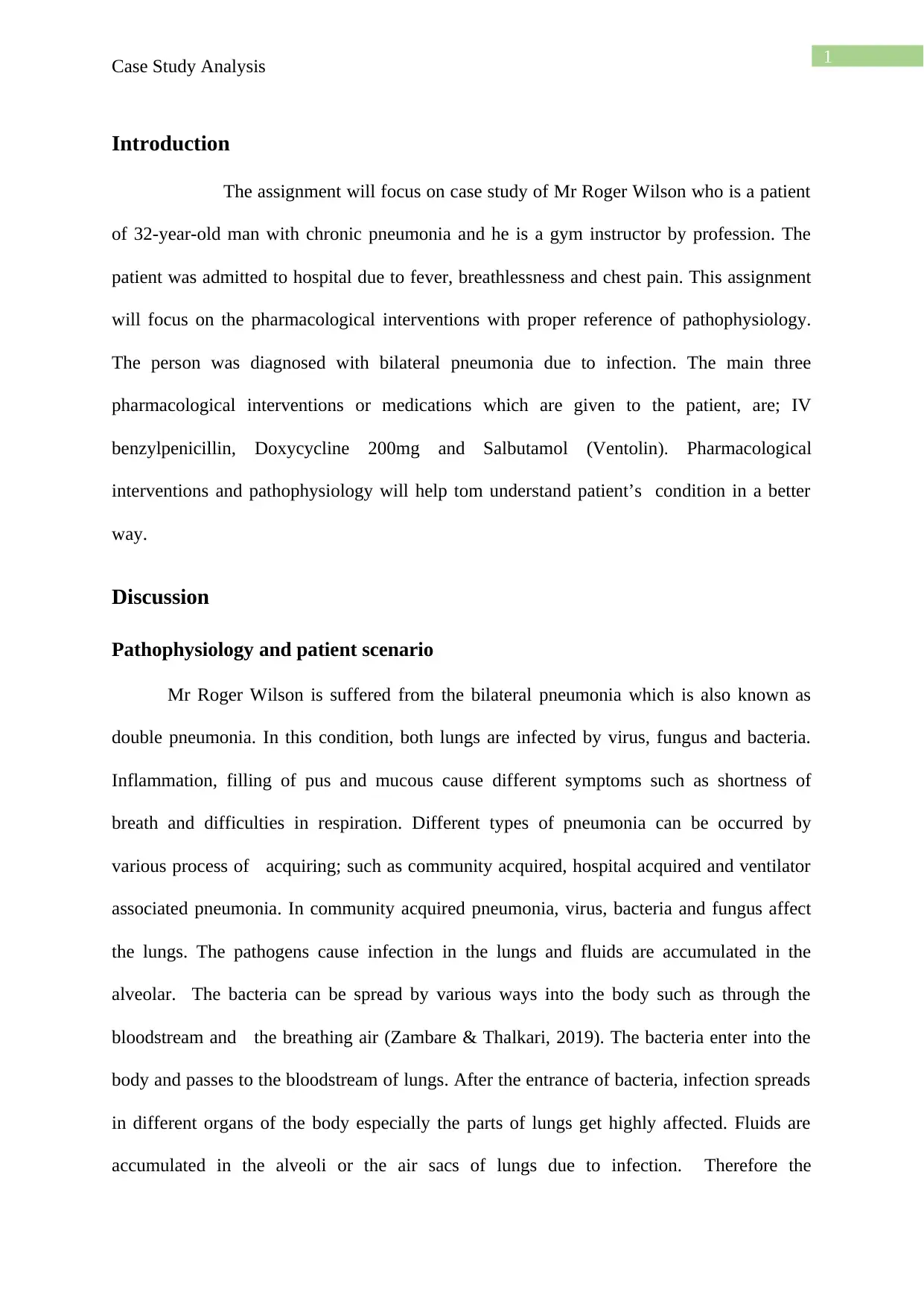
1
Case Study Analysis
Introduction
The assignment will focus on case study of Mr Roger Wilson who is a patient
of 32-year-old man with chronic pneumonia and he is a gym instructor by profession. The
patient was admitted to hospital due to fever, breathlessness and chest pain. This assignment
will focus on the pharmacological interventions with proper reference of pathophysiology.
The person was diagnosed with bilateral pneumonia due to infection. The main three
pharmacological interventions or medications which are given to the patient, are; IV
benzylpenicillin, Doxycycline 200mg and Salbutamol (Ventolin). Pharmacological
interventions and pathophysiology will help tom understand patient’s condition in a better
way.
Discussion
Pathophysiology and patient scenario
Mr Roger Wilson is suffered from the bilateral pneumonia which is also known as
double pneumonia. In this condition, both lungs are infected by virus, fungus and bacteria.
Inflammation, filling of pus and mucous cause different symptoms such as shortness of
breath and difficulties in respiration. Different types of pneumonia can be occurred by
various process of acquiring; such as community acquired, hospital acquired and ventilator
associated pneumonia. In community acquired pneumonia, virus, bacteria and fungus affect
the lungs. The pathogens cause infection in the lungs and fluids are accumulated in the
alveolar. The bacteria can be spread by various ways into the body such as through the
bloodstream and the breathing air (Zambare & Thalkari, 2019). The bacteria enter into the
body and passes to the bloodstream of lungs. After the entrance of bacteria, infection spreads
in different organs of the body especially the parts of lungs get highly affected. Fluids are
accumulated in the alveoli or the air sacs of lungs due to infection. Therefore the
Case Study Analysis
Introduction
The assignment will focus on case study of Mr Roger Wilson who is a patient
of 32-year-old man with chronic pneumonia and he is a gym instructor by profession. The
patient was admitted to hospital due to fever, breathlessness and chest pain. This assignment
will focus on the pharmacological interventions with proper reference of pathophysiology.
The person was diagnosed with bilateral pneumonia due to infection. The main three
pharmacological interventions or medications which are given to the patient, are; IV
benzylpenicillin, Doxycycline 200mg and Salbutamol (Ventolin). Pharmacological
interventions and pathophysiology will help tom understand patient’s condition in a better
way.
Discussion
Pathophysiology and patient scenario
Mr Roger Wilson is suffered from the bilateral pneumonia which is also known as
double pneumonia. In this condition, both lungs are infected by virus, fungus and bacteria.
Inflammation, filling of pus and mucous cause different symptoms such as shortness of
breath and difficulties in respiration. Different types of pneumonia can be occurred by
various process of acquiring; such as community acquired, hospital acquired and ventilator
associated pneumonia. In community acquired pneumonia, virus, bacteria and fungus affect
the lungs. The pathogens cause infection in the lungs and fluids are accumulated in the
alveolar. The bacteria can be spread by various ways into the body such as through the
bloodstream and the breathing air (Zambare & Thalkari, 2019). The bacteria enter into the
body and passes to the bloodstream of lungs. After the entrance of bacteria, infection spreads
in different organs of the body especially the parts of lungs get highly affected. Fluids are
accumulated in the alveoli or the air sacs of lungs due to infection. Therefore the
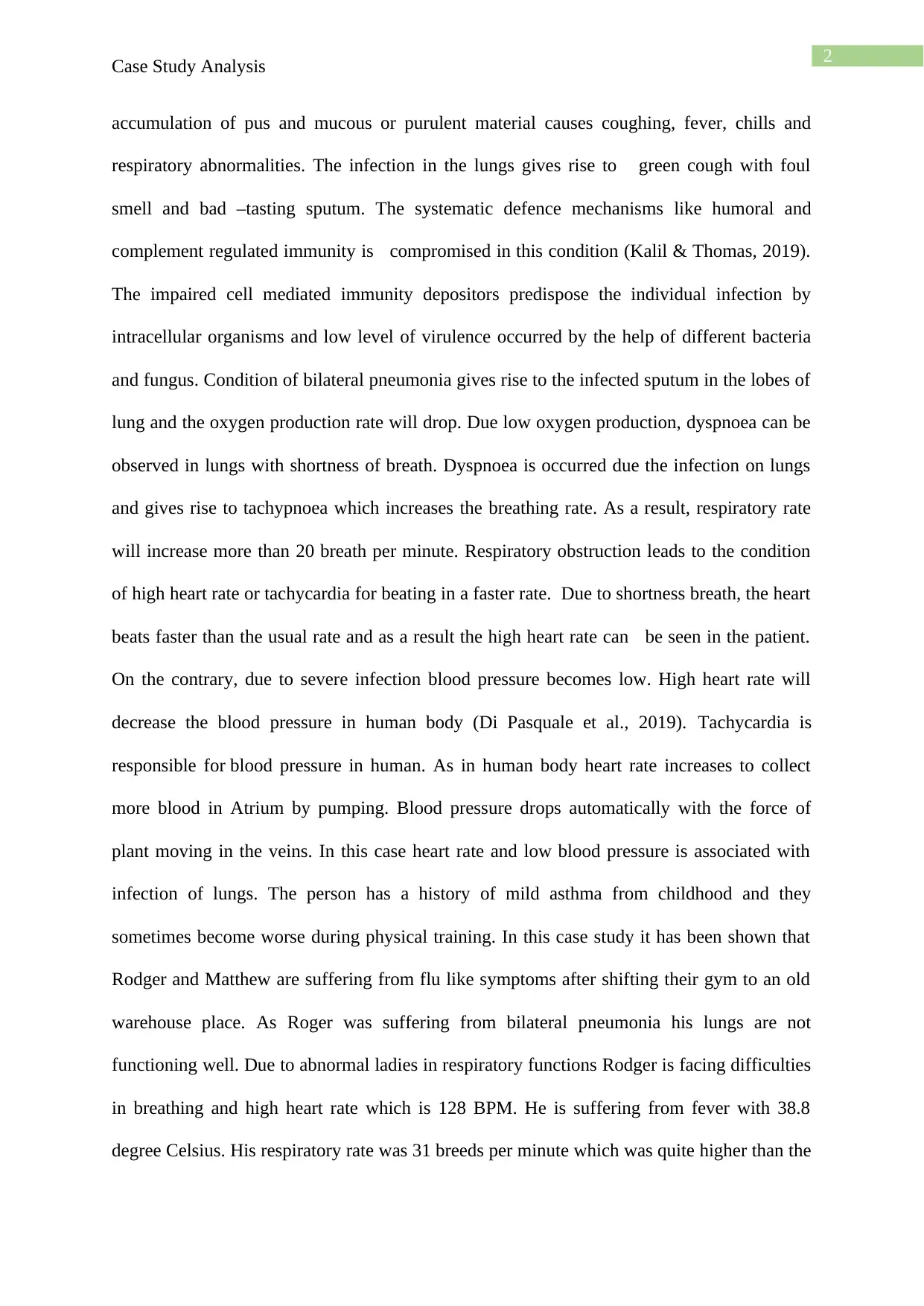
2
Case Study Analysis
accumulation of pus and mucous or purulent material causes coughing, fever, chills and
respiratory abnormalities. The infection in the lungs gives rise to green cough with foul
smell and bad –tasting sputum. The systematic defence mechanisms like humoral and
complement regulated immunity is compromised in this condition (Kalil & Thomas, 2019).
The impaired cell mediated immunity depositors predispose the individual infection by
intracellular organisms and low level of virulence occurred by the help of different bacteria
and fungus. Condition of bilateral pneumonia gives rise to the infected sputum in the lobes of
lung and the oxygen production rate will drop. Due low oxygen production, dyspnoea can be
observed in lungs with shortness of breath. Dyspnoea is occurred due the infection on lungs
and gives rise to tachypnoea which increases the breathing rate. As a result, respiratory rate
will increase more than 20 breath per minute. Respiratory obstruction leads to the condition
of high heart rate or tachycardia for beating in a faster rate. Due to shortness breath, the heart
beats faster than the usual rate and as a result the high heart rate can be seen in the patient.
On the contrary, due to severe infection blood pressure becomes low. High heart rate will
decrease the blood pressure in human body (Di Pasquale et al., 2019). Tachycardia is
responsible for blood pressure in human. As in human body heart rate increases to collect
more blood in Atrium by pumping. Blood pressure drops automatically with the force of
plant moving in the veins. In this case heart rate and low blood pressure is associated with
infection of lungs. The person has a history of mild asthma from childhood and they
sometimes become worse during physical training. In this case study it has been shown that
Rodger and Matthew are suffering from flu like symptoms after shifting their gym to an old
warehouse place. As Roger was suffering from bilateral pneumonia his lungs are not
functioning well. Due to abnormal ladies in respiratory functions Rodger is facing difficulties
in breathing and high heart rate which is 128 BPM. He is suffering from fever with 38.8
degree Celsius. His respiratory rate was 31 breeds per minute which was quite higher than the
Case Study Analysis
accumulation of pus and mucous or purulent material causes coughing, fever, chills and
respiratory abnormalities. The infection in the lungs gives rise to green cough with foul
smell and bad –tasting sputum. The systematic defence mechanisms like humoral and
complement regulated immunity is compromised in this condition (Kalil & Thomas, 2019).
The impaired cell mediated immunity depositors predispose the individual infection by
intracellular organisms and low level of virulence occurred by the help of different bacteria
and fungus. Condition of bilateral pneumonia gives rise to the infected sputum in the lobes of
lung and the oxygen production rate will drop. Due low oxygen production, dyspnoea can be
observed in lungs with shortness of breath. Dyspnoea is occurred due the infection on lungs
and gives rise to tachypnoea which increases the breathing rate. As a result, respiratory rate
will increase more than 20 breath per minute. Respiratory obstruction leads to the condition
of high heart rate or tachycardia for beating in a faster rate. Due to shortness breath, the heart
beats faster than the usual rate and as a result the high heart rate can be seen in the patient.
On the contrary, due to severe infection blood pressure becomes low. High heart rate will
decrease the blood pressure in human body (Di Pasquale et al., 2019). Tachycardia is
responsible for blood pressure in human. As in human body heart rate increases to collect
more blood in Atrium by pumping. Blood pressure drops automatically with the force of
plant moving in the veins. In this case heart rate and low blood pressure is associated with
infection of lungs. The person has a history of mild asthma from childhood and they
sometimes become worse during physical training. In this case study it has been shown that
Rodger and Matthew are suffering from flu like symptoms after shifting their gym to an old
warehouse place. As Roger was suffering from bilateral pneumonia his lungs are not
functioning well. Due to abnormal ladies in respiratory functions Rodger is facing difficulties
in breathing and high heart rate which is 128 BPM. He is suffering from fever with 38.8
degree Celsius. His respiratory rate was 31 breeds per minute which was quite higher than the
⊘ This is a preview!⊘
Do you want full access?
Subscribe today to unlock all pages.

Trusted by 1+ million students worldwide
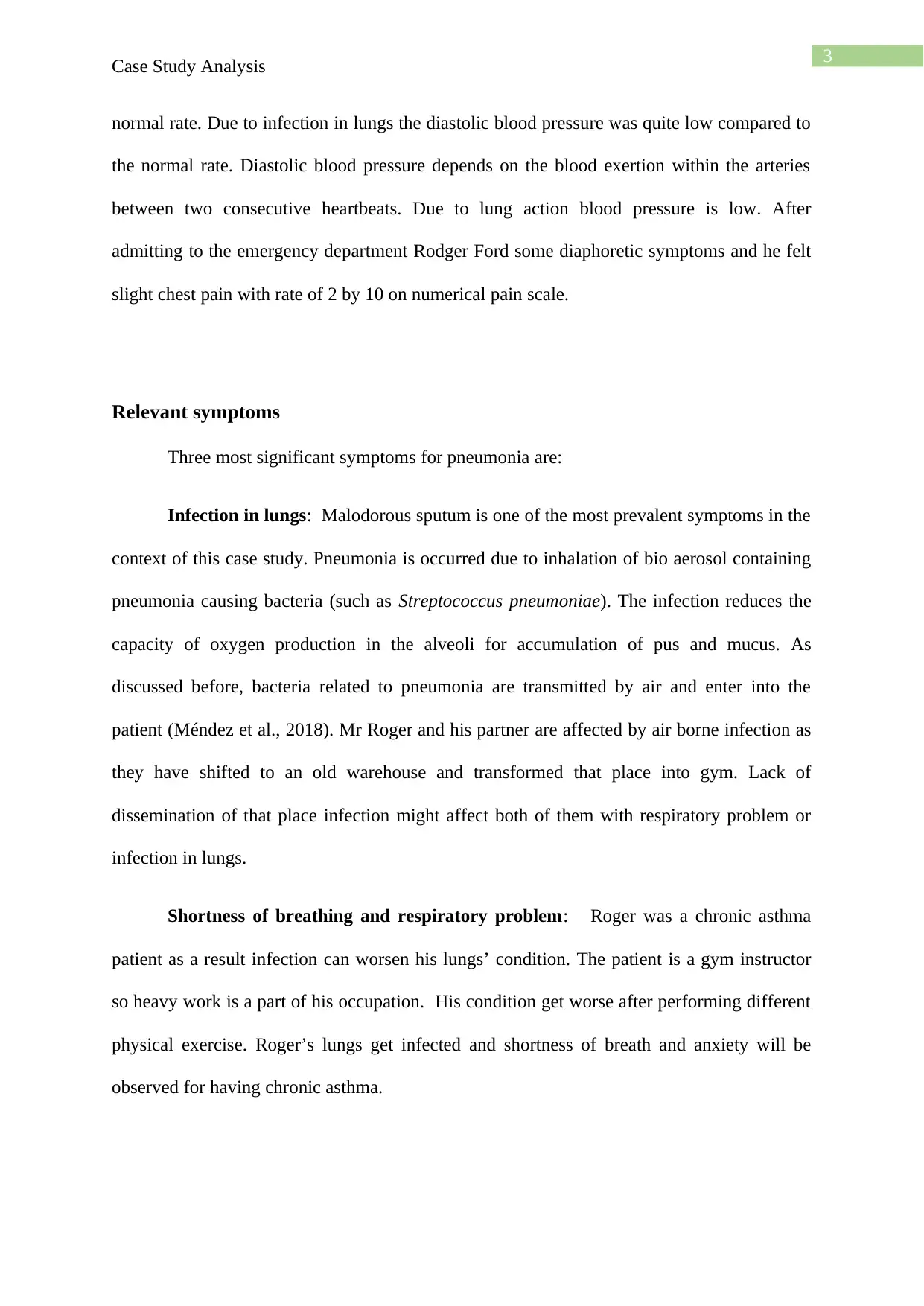
3
Case Study Analysis
normal rate. Due to infection in lungs the diastolic blood pressure was quite low compared to
the normal rate. Diastolic blood pressure depends on the blood exertion within the arteries
between two consecutive heartbeats. Due to lung action blood pressure is low. After
admitting to the emergency department Rodger Ford some diaphoretic symptoms and he felt
slight chest pain with rate of 2 by 10 on numerical pain scale.
Relevant symptoms
Three most significant symptoms for pneumonia are:
Infection in lungs: Malodorous sputum is one of the most prevalent symptoms in the
context of this case study. Pneumonia is occurred due to inhalation of bio aerosol containing
pneumonia causing bacteria (such as Streptococcus pneumoniae). The infection reduces the
capacity of oxygen production in the alveoli for accumulation of pus and mucus. As
discussed before, bacteria related to pneumonia are transmitted by air and enter into the
patient (Méndez et al., 2018). Mr Roger and his partner are affected by air borne infection as
they have shifted to an old warehouse and transformed that place into gym. Lack of
dissemination of that place infection might affect both of them with respiratory problem or
infection in lungs.
Shortness of breathing and respiratory problem: Roger was a chronic asthma
patient as a result infection can worsen his lungs’ condition. The patient is a gym instructor
so heavy work is a part of his occupation. His condition get worse after performing different
physical exercise. Roger’s lungs get infected and shortness of breath and anxiety will be
observed for having chronic asthma.
Case Study Analysis
normal rate. Due to infection in lungs the diastolic blood pressure was quite low compared to
the normal rate. Diastolic blood pressure depends on the blood exertion within the arteries
between two consecutive heartbeats. Due to lung action blood pressure is low. After
admitting to the emergency department Rodger Ford some diaphoretic symptoms and he felt
slight chest pain with rate of 2 by 10 on numerical pain scale.
Relevant symptoms
Three most significant symptoms for pneumonia are:
Infection in lungs: Malodorous sputum is one of the most prevalent symptoms in the
context of this case study. Pneumonia is occurred due to inhalation of bio aerosol containing
pneumonia causing bacteria (such as Streptococcus pneumoniae). The infection reduces the
capacity of oxygen production in the alveoli for accumulation of pus and mucus. As
discussed before, bacteria related to pneumonia are transmitted by air and enter into the
patient (Méndez et al., 2018). Mr Roger and his partner are affected by air borne infection as
they have shifted to an old warehouse and transformed that place into gym. Lack of
dissemination of that place infection might affect both of them with respiratory problem or
infection in lungs.
Shortness of breathing and respiratory problem: Roger was a chronic asthma
patient as a result infection can worsen his lungs’ condition. The patient is a gym instructor
so heavy work is a part of his occupation. His condition get worse after performing different
physical exercise. Roger’s lungs get infected and shortness of breath and anxiety will be
observed for having chronic asthma.
Paraphrase This Document
Need a fresh take? Get an instant paraphrase of this document with our AI Paraphraser
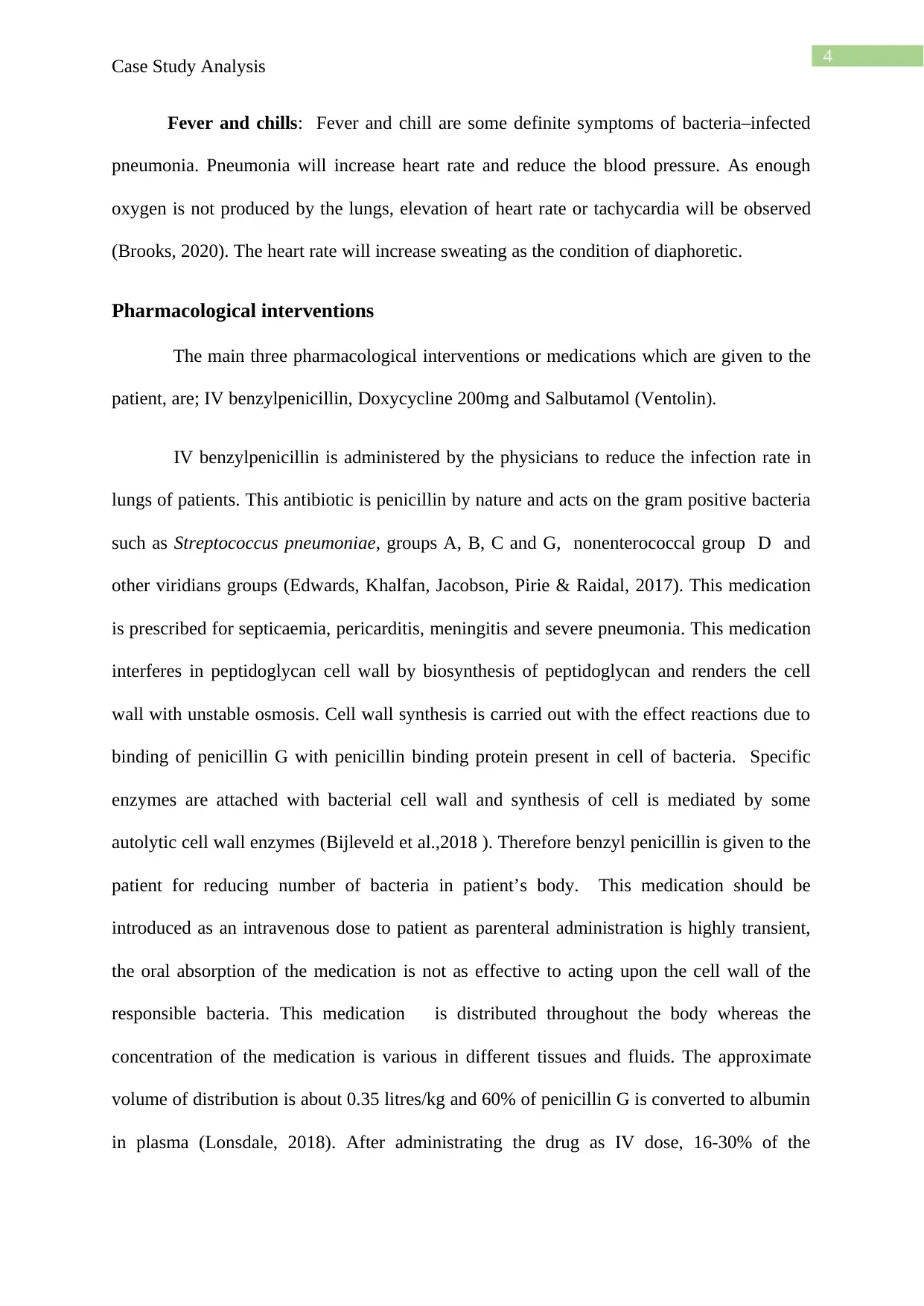
4
Case Study Analysis
Fever and chills: Fever and chill are some definite symptoms of bacteria–infected
pneumonia. Pneumonia will increase heart rate and reduce the blood pressure. As enough
oxygen is not produced by the lungs, elevation of heart rate or tachycardia will be observed
(Brooks, 2020). The heart rate will increase sweating as the condition of diaphoretic.
Pharmacological interventions
The main three pharmacological interventions or medications which are given to the
patient, are; IV benzylpenicillin, Doxycycline 200mg and Salbutamol (Ventolin).
IV benzylpenicillin is administered by the physicians to reduce the infection rate in
lungs of patients. This antibiotic is penicillin by nature and acts on the gram positive bacteria
such as Streptococcus pneumoniae, groups A, B, C and G, nonenterococcal group D and
other viridians groups (Edwards, Khalfan, Jacobson, Pirie & Raidal, 2017). This medication
is prescribed for septicaemia, pericarditis, meningitis and severe pneumonia. This medication
interferes in peptidoglycan cell wall by biosynthesis of peptidoglycan and renders the cell
wall with unstable osmosis. Cell wall synthesis is carried out with the effect reactions due to
binding of penicillin G with penicillin binding protein present in cell of bacteria. Specific
enzymes are attached with bacterial cell wall and synthesis of cell is mediated by some
autolytic cell wall enzymes (Bijleveld et al.,2018 ). Therefore benzyl penicillin is given to the
patient for reducing number of bacteria in patient’s body. This medication should be
introduced as an intravenous dose to patient as parenteral administration is highly transient,
the oral absorption of the medication is not as effective to acting upon the cell wall of the
responsible bacteria. This medication is distributed throughout the body whereas the
concentration of the medication is various in different tissues and fluids. The approximate
volume of distribution is about 0.35 litres/kg and 60% of penicillin G is converted to albumin
in plasma (Lonsdale, 2018). After administrating the drug as IV dose, 16-30% of the
Case Study Analysis
Fever and chills: Fever and chill are some definite symptoms of bacteria–infected
pneumonia. Pneumonia will increase heart rate and reduce the blood pressure. As enough
oxygen is not produced by the lungs, elevation of heart rate or tachycardia will be observed
(Brooks, 2020). The heart rate will increase sweating as the condition of diaphoretic.
Pharmacological interventions
The main three pharmacological interventions or medications which are given to the
patient, are; IV benzylpenicillin, Doxycycline 200mg and Salbutamol (Ventolin).
IV benzylpenicillin is administered by the physicians to reduce the infection rate in
lungs of patients. This antibiotic is penicillin by nature and acts on the gram positive bacteria
such as Streptococcus pneumoniae, groups A, B, C and G, nonenterococcal group D and
other viridians groups (Edwards, Khalfan, Jacobson, Pirie & Raidal, 2017). This medication
is prescribed for septicaemia, pericarditis, meningitis and severe pneumonia. This medication
interferes in peptidoglycan cell wall by biosynthesis of peptidoglycan and renders the cell
wall with unstable osmosis. Cell wall synthesis is carried out with the effect reactions due to
binding of penicillin G with penicillin binding protein present in cell of bacteria. Specific
enzymes are attached with bacterial cell wall and synthesis of cell is mediated by some
autolytic cell wall enzymes (Bijleveld et al.,2018 ). Therefore benzyl penicillin is given to the
patient for reducing number of bacteria in patient’s body. This medication should be
introduced as an intravenous dose to patient as parenteral administration is highly transient,
the oral absorption of the medication is not as effective to acting upon the cell wall of the
responsible bacteria. This medication is distributed throughout the body whereas the
concentration of the medication is various in different tissues and fluids. The approximate
volume of distribution is about 0.35 litres/kg and 60% of penicillin G is converted to albumin
in plasma (Lonsdale, 2018). After administrating the drug as IV dose, 16-30% of the
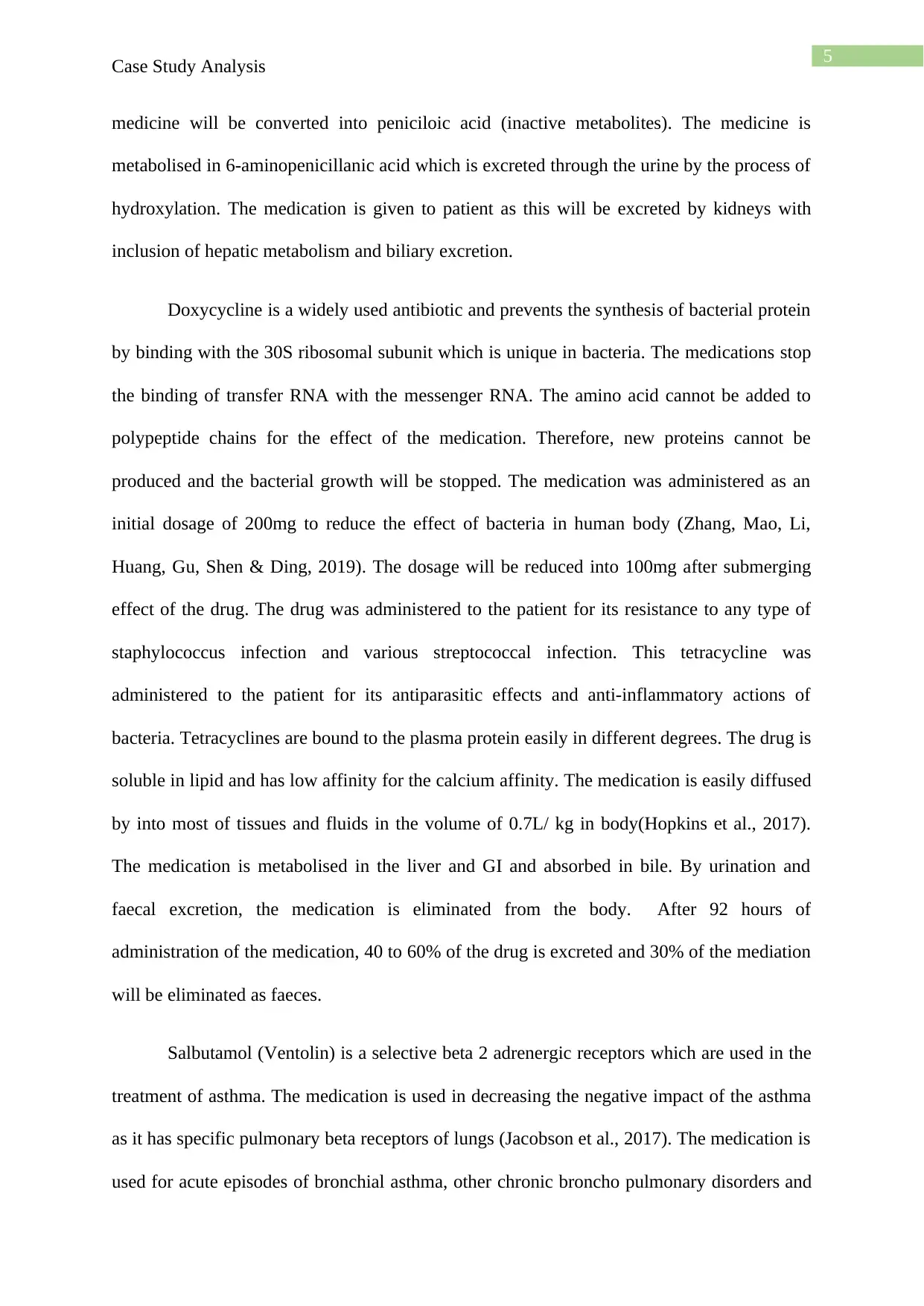
5
Case Study Analysis
medicine will be converted into peniciloic acid (inactive metabolites). The medicine is
metabolised in 6-aminopenicillanic acid which is excreted through the urine by the process of
hydroxylation. The medication is given to patient as this will be excreted by kidneys with
inclusion of hepatic metabolism and biliary excretion.
Doxycycline is a widely used antibiotic and prevents the synthesis of bacterial protein
by binding with the 30S ribosomal subunit which is unique in bacteria. The medications stop
the binding of transfer RNA with the messenger RNA. The amino acid cannot be added to
polypeptide chains for the effect of the medication. Therefore, new proteins cannot be
produced and the bacterial growth will be stopped. The medication was administered as an
initial dosage of 200mg to reduce the effect of bacteria in human body (Zhang, Mao, Li,
Huang, Gu, Shen & Ding, 2019). The dosage will be reduced into 100mg after submerging
effect of the drug. The drug was administered to the patient for its resistance to any type of
staphylococcus infection and various streptococcal infection. This tetracycline was
administered to the patient for its antiparasitic effects and anti-inflammatory actions of
bacteria. Tetracyclines are bound to the plasma protein easily in different degrees. The drug is
soluble in lipid and has low affinity for the calcium affinity. The medication is easily diffused
by into most of tissues and fluids in the volume of 0.7L/ kg in body(Hopkins et al., 2017).
The medication is metabolised in the liver and GI and absorbed in bile. By urination and
faecal excretion, the medication is eliminated from the body. After 92 hours of
administration of the medication, 40 to 60% of the drug is excreted and 30% of the mediation
will be eliminated as faeces.
Salbutamol (Ventolin) is a selective beta 2 adrenergic receptors which are used in the
treatment of asthma. The medication is used in decreasing the negative impact of the asthma
as it has specific pulmonary beta receptors of lungs (Jacobson et al., 2017). The medication is
used for acute episodes of bronchial asthma, other chronic broncho pulmonary disorders and
Case Study Analysis
medicine will be converted into peniciloic acid (inactive metabolites). The medicine is
metabolised in 6-aminopenicillanic acid which is excreted through the urine by the process of
hydroxylation. The medication is given to patient as this will be excreted by kidneys with
inclusion of hepatic metabolism and biliary excretion.
Doxycycline is a widely used antibiotic and prevents the synthesis of bacterial protein
by binding with the 30S ribosomal subunit which is unique in bacteria. The medications stop
the binding of transfer RNA with the messenger RNA. The amino acid cannot be added to
polypeptide chains for the effect of the medication. Therefore, new proteins cannot be
produced and the bacterial growth will be stopped. The medication was administered as an
initial dosage of 200mg to reduce the effect of bacteria in human body (Zhang, Mao, Li,
Huang, Gu, Shen & Ding, 2019). The dosage will be reduced into 100mg after submerging
effect of the drug. The drug was administered to the patient for its resistance to any type of
staphylococcus infection and various streptococcal infection. This tetracycline was
administered to the patient for its antiparasitic effects and anti-inflammatory actions of
bacteria. Tetracyclines are bound to the plasma protein easily in different degrees. The drug is
soluble in lipid and has low affinity for the calcium affinity. The medication is easily diffused
by into most of tissues and fluids in the volume of 0.7L/ kg in body(Hopkins et al., 2017).
The medication is metabolised in the liver and GI and absorbed in bile. By urination and
faecal excretion, the medication is eliminated from the body. After 92 hours of
administration of the medication, 40 to 60% of the drug is excreted and 30% of the mediation
will be eliminated as faeces.
Salbutamol (Ventolin) is a selective beta 2 adrenergic receptors which are used in the
treatment of asthma. The medication is used in decreasing the negative impact of the asthma
as it has specific pulmonary beta receptors of lungs (Jacobson et al., 2017). The medication is
used for acute episodes of bronchial asthma, other chronic broncho pulmonary disorders and
⊘ This is a preview!⊘
Do you want full access?
Subscribe today to unlock all pages.

Trusted by 1+ million students worldwide
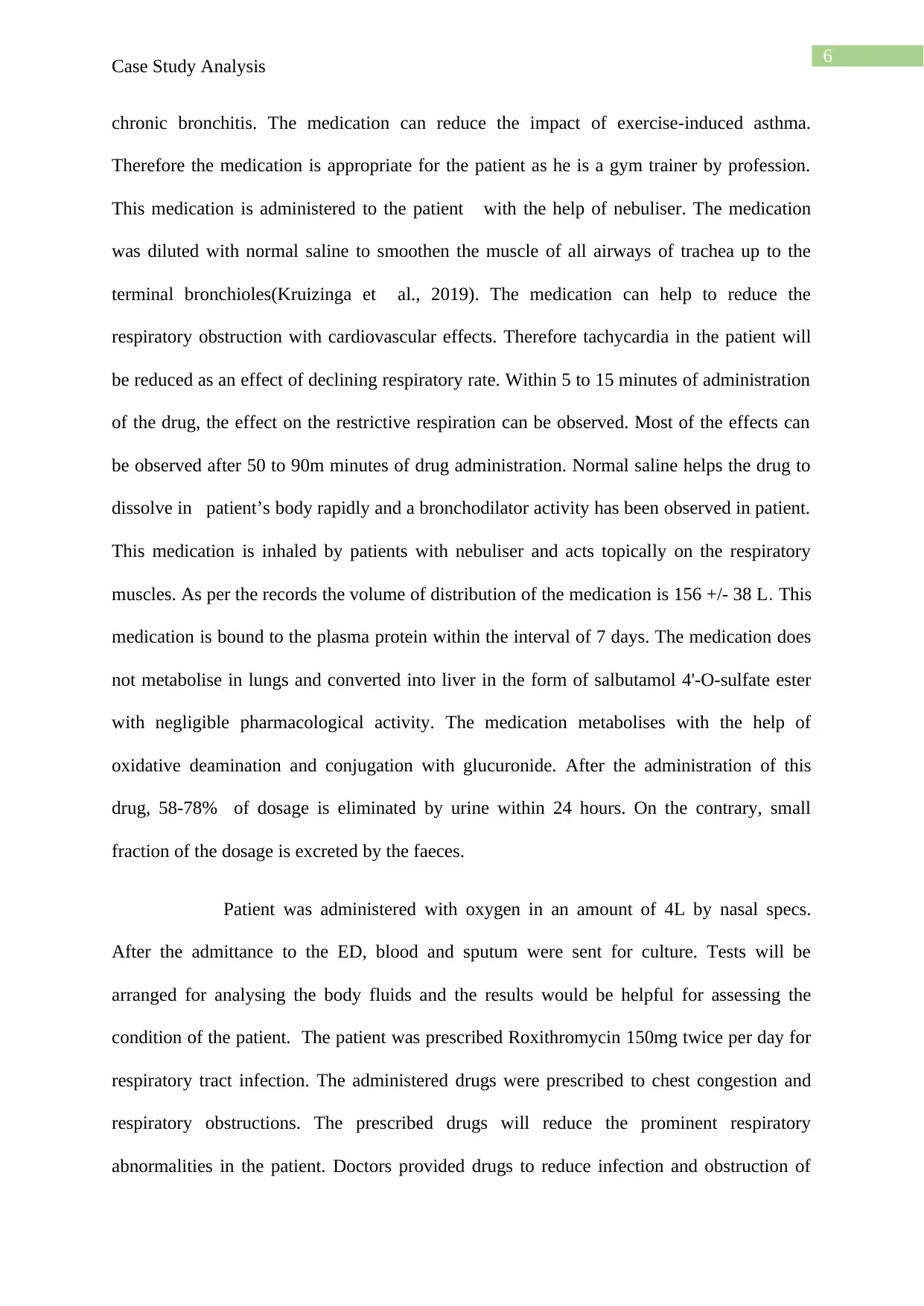
6
Case Study Analysis
chronic bronchitis. The medication can reduce the impact of exercise-induced asthma.
Therefore the medication is appropriate for the patient as he is a gym trainer by profession.
This medication is administered to the patient with the help of nebuliser. The medication
was diluted with normal saline to smoothen the muscle of all airways of trachea up to the
terminal bronchioles(Kruizinga et al., 2019). The medication can help to reduce the
respiratory obstruction with cardiovascular effects. Therefore tachycardia in the patient will
be reduced as an effect of declining respiratory rate. Within 5 to 15 minutes of administration
of the drug, the effect on the restrictive respiration can be observed. Most of the effects can
be observed after 50 to 90m minutes of drug administration. Normal saline helps the drug to
dissolve in patient’s body rapidly and a bronchodilator activity has been observed in patient.
This medication is inhaled by patients with nebuliser and acts topically on the respiratory
muscles. As per the records the volume of distribution of the medication is 156 +/- 38 L. This
medication is bound to the plasma protein within the interval of 7 days. The medication does
not metabolise in lungs and converted into liver in the form of salbutamol 4'-O-sulfate ester
with negligible pharmacological activity. The medication metabolises with the help of
oxidative deamination and conjugation with glucuronide. After the administration of this
drug, 58-78% of dosage is eliminated by urine within 24 hours. On the contrary, small
fraction of the dosage is excreted by the faeces.
Patient was administered with oxygen in an amount of 4L by nasal specs.
After the admittance to the ED, blood and sputum were sent for culture. Tests will be
arranged for analysing the body fluids and the results would be helpful for assessing the
condition of the patient. The patient was prescribed Roxithromycin 150mg twice per day for
respiratory tract infection. The administered drugs were prescribed to chest congestion and
respiratory obstructions. The prescribed drugs will reduce the prominent respiratory
abnormalities in the patient. Doctors provided drugs to reduce infection and obstruction of
Case Study Analysis
chronic bronchitis. The medication can reduce the impact of exercise-induced asthma.
Therefore the medication is appropriate for the patient as he is a gym trainer by profession.
This medication is administered to the patient with the help of nebuliser. The medication
was diluted with normal saline to smoothen the muscle of all airways of trachea up to the
terminal bronchioles(Kruizinga et al., 2019). The medication can help to reduce the
respiratory obstruction with cardiovascular effects. Therefore tachycardia in the patient will
be reduced as an effect of declining respiratory rate. Within 5 to 15 minutes of administration
of the drug, the effect on the restrictive respiration can be observed. Most of the effects can
be observed after 50 to 90m minutes of drug administration. Normal saline helps the drug to
dissolve in patient’s body rapidly and a bronchodilator activity has been observed in patient.
This medication is inhaled by patients with nebuliser and acts topically on the respiratory
muscles. As per the records the volume of distribution of the medication is 156 +/- 38 L. This
medication is bound to the plasma protein within the interval of 7 days. The medication does
not metabolise in lungs and converted into liver in the form of salbutamol 4'-O-sulfate ester
with negligible pharmacological activity. The medication metabolises with the help of
oxidative deamination and conjugation with glucuronide. After the administration of this
drug, 58-78% of dosage is eliminated by urine within 24 hours. On the contrary, small
fraction of the dosage is excreted by the faeces.
Patient was administered with oxygen in an amount of 4L by nasal specs.
After the admittance to the ED, blood and sputum were sent for culture. Tests will be
arranged for analysing the body fluids and the results would be helpful for assessing the
condition of the patient. The patient was prescribed Roxithromycin 150mg twice per day for
respiratory tract infection. The administered drugs were prescribed to chest congestion and
respiratory obstructions. The prescribed drugs will reduce the prominent respiratory
abnormalities in the patient. Doctors provided drugs to reduce infection and obstruction of
Paraphrase This Document
Need a fresh take? Get an instant paraphrase of this document with our AI Paraphraser
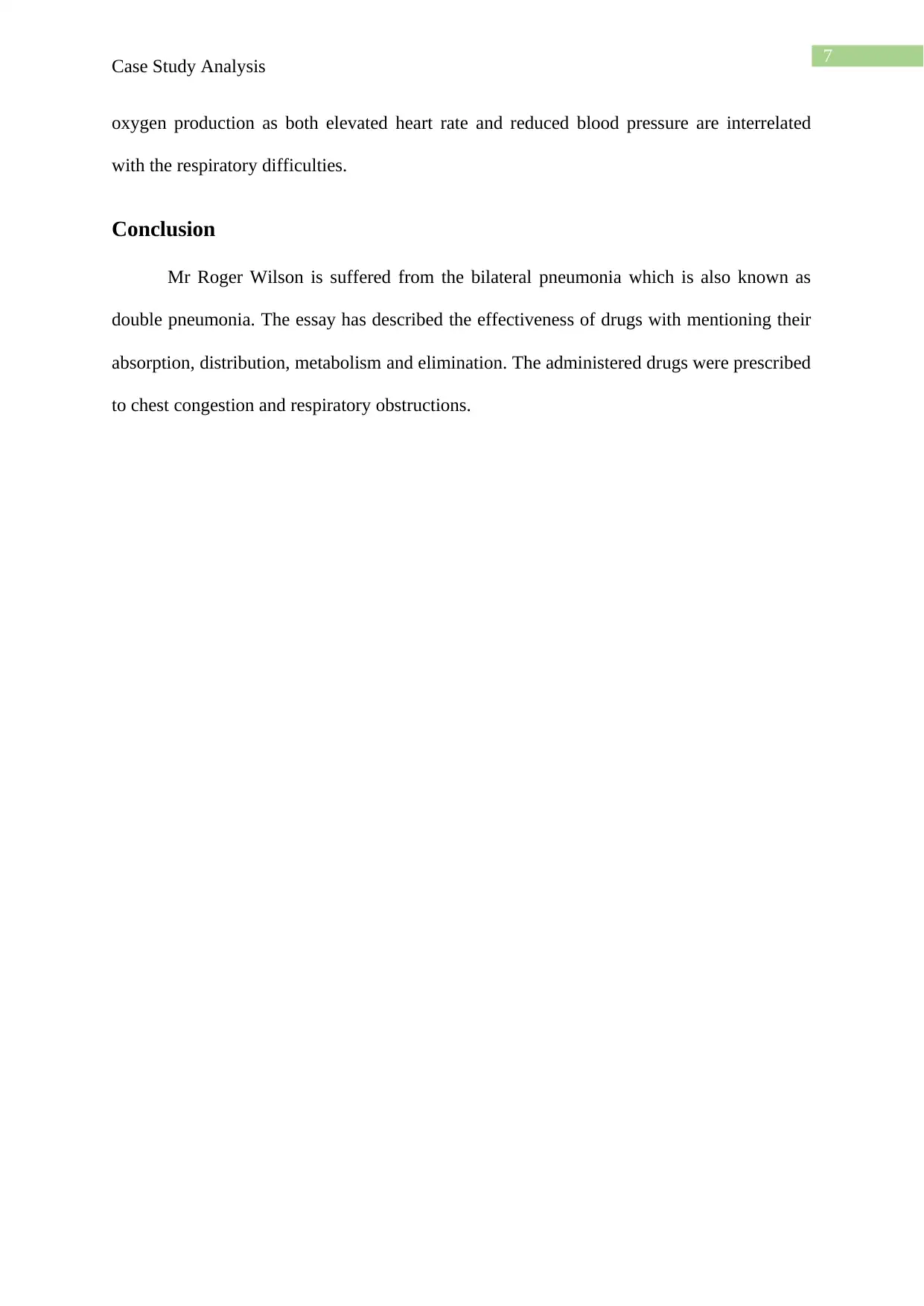
7
Case Study Analysis
oxygen production as both elevated heart rate and reduced blood pressure are interrelated
with the respiratory difficulties.
Conclusion
Mr Roger Wilson is suffered from the bilateral pneumonia which is also known as
double pneumonia. The essay has described the effectiveness of drugs with mentioning their
absorption, distribution, metabolism and elimination. The administered drugs were prescribed
to chest congestion and respiratory obstructions.
Case Study Analysis
oxygen production as both elevated heart rate and reduced blood pressure are interrelated
with the respiratory difficulties.
Conclusion
Mr Roger Wilson is suffered from the bilateral pneumonia which is also known as
double pneumonia. The essay has described the effectiveness of drugs with mentioning their
absorption, distribution, metabolism and elimination. The administered drugs were prescribed
to chest congestion and respiratory obstructions.
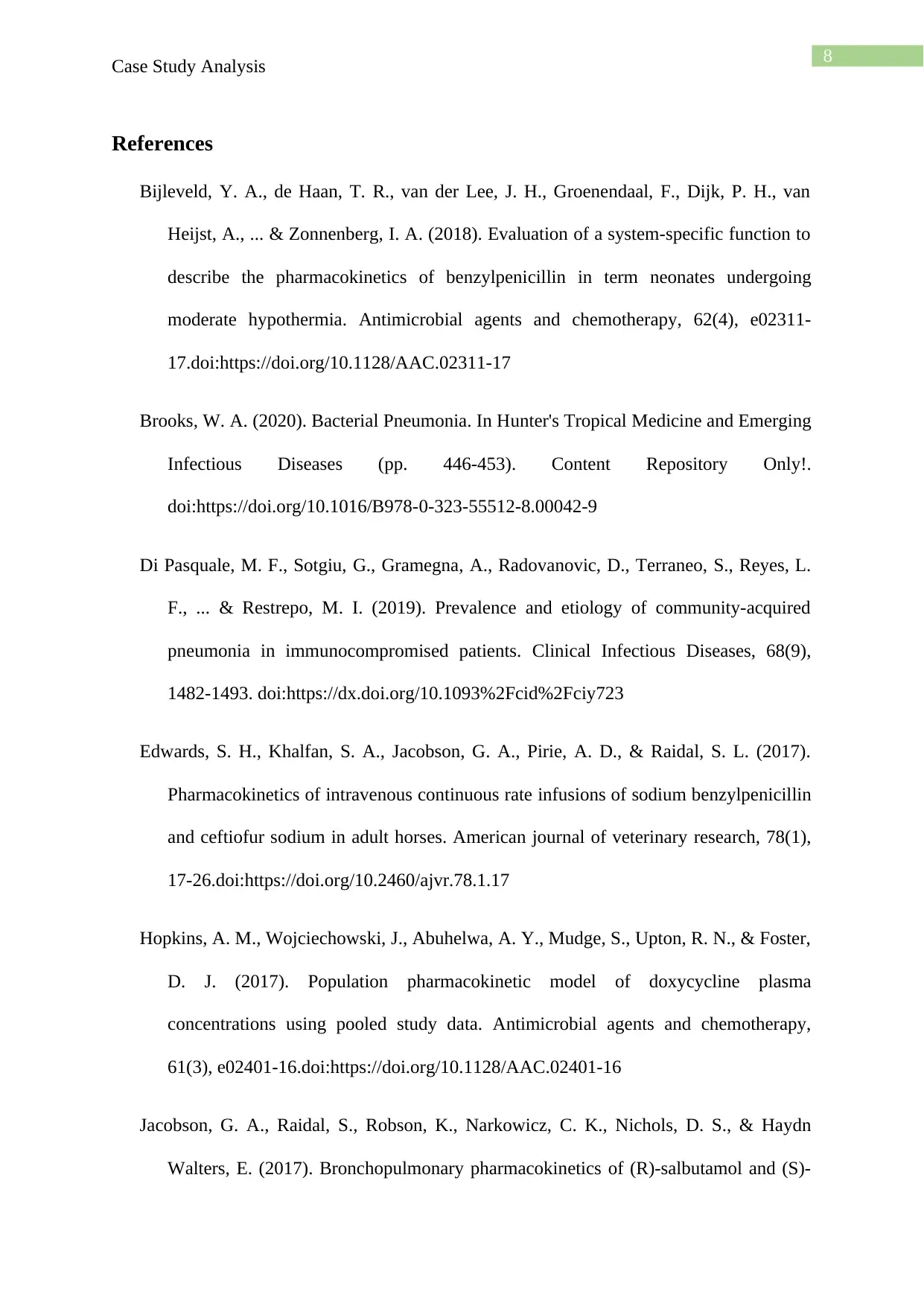
8
Case Study Analysis
References
Bijleveld, Y. A., de Haan, T. R., van der Lee, J. H., Groenendaal, F., Dijk, P. H., van
Heijst, A., ... & Zonnenberg, I. A. (2018). Evaluation of a system-specific function to
describe the pharmacokinetics of benzylpenicillin in term neonates undergoing
moderate hypothermia. Antimicrobial agents and chemotherapy, 62(4), e02311-
17.doi:https://doi.org/10.1128/AAC.02311-17
Brooks, W. A. (2020). Bacterial Pneumonia. In Hunter's Tropical Medicine and Emerging
Infectious Diseases (pp. 446-453). Content Repository Only!.
doi:https://doi.org/10.1016/B978-0-323-55512-8.00042-9
Di Pasquale, M. F., Sotgiu, G., Gramegna, A., Radovanovic, D., Terraneo, S., Reyes, L.
F., ... & Restrepo, M. I. (2019). Prevalence and etiology of community-acquired
pneumonia in immunocompromised patients. Clinical Infectious Diseases, 68(9),
1482-1493. doi:https://dx.doi.org/10.1093%2Fcid%2Fciy723
Edwards, S. H., Khalfan, S. A., Jacobson, G. A., Pirie, A. D., & Raidal, S. L. (2017).
Pharmacokinetics of intravenous continuous rate infusions of sodium benzylpenicillin
and ceftiofur sodium in adult horses. American journal of veterinary research, 78(1),
17-26.doi:https://doi.org/10.2460/ajvr.78.1.17
Hopkins, A. M., Wojciechowski, J., Abuhelwa, A. Y., Mudge, S., Upton, R. N., & Foster,
D. J. (2017). Population pharmacokinetic model of doxycycline plasma
concentrations using pooled study data. Antimicrobial agents and chemotherapy,
61(3), e02401-16.doi:https://doi.org/10.1128/AAC.02401-16
Jacobson, G. A., Raidal, S., Robson, K., Narkowicz, C. K., Nichols, D. S., & Haydn
Walters, E. (2017). Bronchopulmonary pharmacokinetics of (R)‐salbutamol and (S)‐
Case Study Analysis
References
Bijleveld, Y. A., de Haan, T. R., van der Lee, J. H., Groenendaal, F., Dijk, P. H., van
Heijst, A., ... & Zonnenberg, I. A. (2018). Evaluation of a system-specific function to
describe the pharmacokinetics of benzylpenicillin in term neonates undergoing
moderate hypothermia. Antimicrobial agents and chemotherapy, 62(4), e02311-
17.doi:https://doi.org/10.1128/AAC.02311-17
Brooks, W. A. (2020). Bacterial Pneumonia. In Hunter's Tropical Medicine and Emerging
Infectious Diseases (pp. 446-453). Content Repository Only!.
doi:https://doi.org/10.1016/B978-0-323-55512-8.00042-9
Di Pasquale, M. F., Sotgiu, G., Gramegna, A., Radovanovic, D., Terraneo, S., Reyes, L.
F., ... & Restrepo, M. I. (2019). Prevalence and etiology of community-acquired
pneumonia in immunocompromised patients. Clinical Infectious Diseases, 68(9),
1482-1493. doi:https://dx.doi.org/10.1093%2Fcid%2Fciy723
Edwards, S. H., Khalfan, S. A., Jacobson, G. A., Pirie, A. D., & Raidal, S. L. (2017).
Pharmacokinetics of intravenous continuous rate infusions of sodium benzylpenicillin
and ceftiofur sodium in adult horses. American journal of veterinary research, 78(1),
17-26.doi:https://doi.org/10.2460/ajvr.78.1.17
Hopkins, A. M., Wojciechowski, J., Abuhelwa, A. Y., Mudge, S., Upton, R. N., & Foster,
D. J. (2017). Population pharmacokinetic model of doxycycline plasma
concentrations using pooled study data. Antimicrobial agents and chemotherapy,
61(3), e02401-16.doi:https://doi.org/10.1128/AAC.02401-16
Jacobson, G. A., Raidal, S., Robson, K., Narkowicz, C. K., Nichols, D. S., & Haydn
Walters, E. (2017). Bronchopulmonary pharmacokinetics of (R)‐salbutamol and (S)‐
⊘ This is a preview!⊘
Do you want full access?
Subscribe today to unlock all pages.

Trusted by 1+ million students worldwide
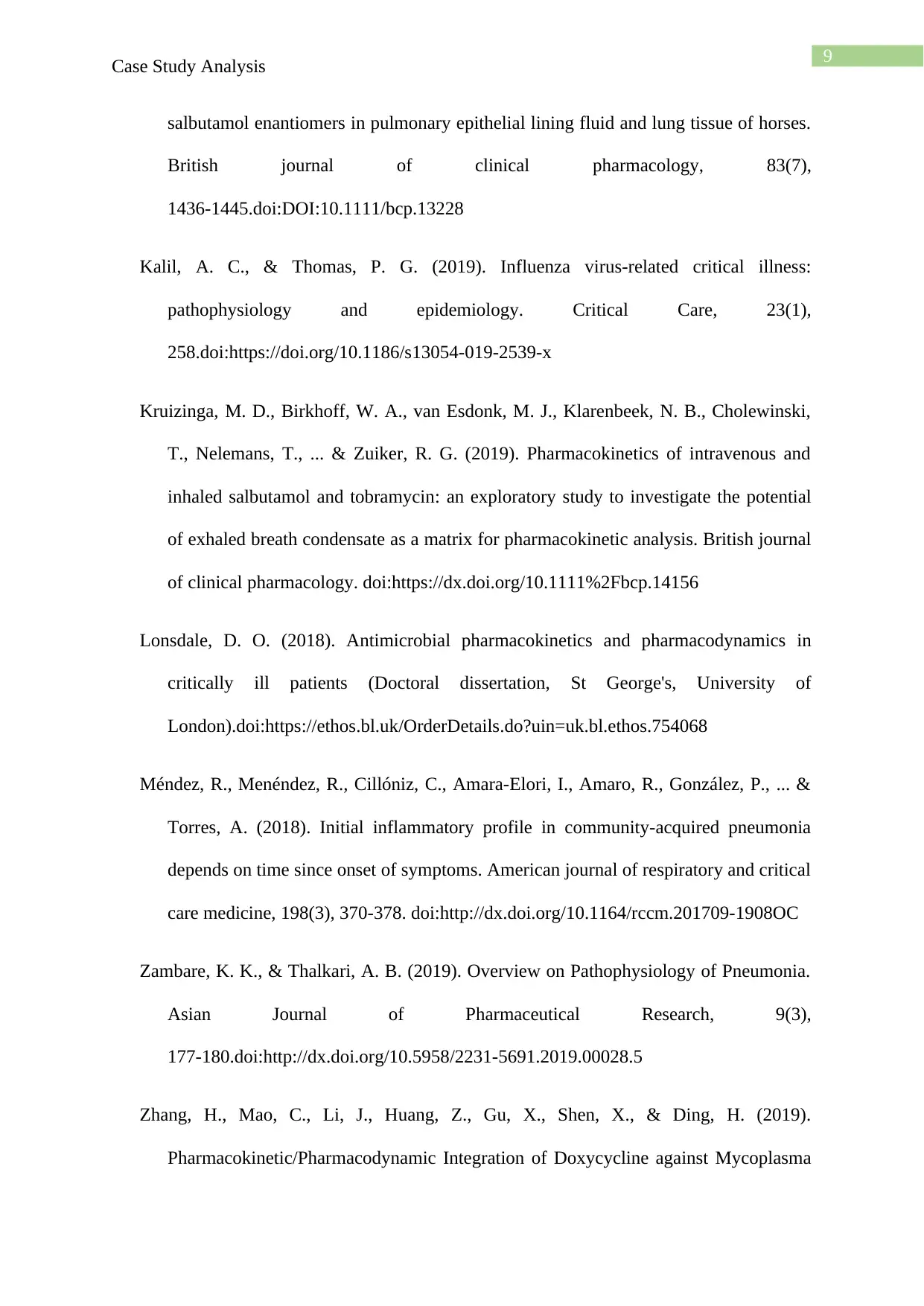
9
Case Study Analysis
salbutamol enantiomers in pulmonary epithelial lining fluid and lung tissue of horses.
British journal of clinical pharmacology, 83(7),
1436-1445.doi:DOI:10.1111/bcp.13228
Kalil, A. C., & Thomas, P. G. (2019). Influenza virus-related critical illness:
pathophysiology and epidemiology. Critical Care, 23(1),
258.doi:https://doi.org/10.1186/s13054-019-2539-x
Kruizinga, M. D., Birkhoff, W. A., van Esdonk, M. J., Klarenbeek, N. B., Cholewinski,
T., Nelemans, T., ... & Zuiker, R. G. (2019). Pharmacokinetics of intravenous and
inhaled salbutamol and tobramycin: an exploratory study to investigate the potential
of exhaled breath condensate as a matrix for pharmacokinetic analysis. British journal
of clinical pharmacology. doi:https://dx.doi.org/10.1111%2Fbcp.14156
Lonsdale, D. O. (2018). Antimicrobial pharmacokinetics and pharmacodynamics in
critically ill patients (Doctoral dissertation, St George's, University of
London).doi:https://ethos.bl.uk/OrderDetails.do?uin=uk.bl.ethos.754068
Méndez, R., Menéndez, R., Cillóniz, C., Amara-Elori, I., Amaro, R., González, P., ... &
Torres, A. (2018). Initial inflammatory profile in community-acquired pneumonia
depends on time since onset of symptoms. American journal of respiratory and critical
care medicine, 198(3), 370-378. doi:http://dx.doi.org/10.1164/rccm.201709-1908OC
Zambare, K. K., & Thalkari, A. B. (2019). Overview on Pathophysiology of Pneumonia.
Asian Journal of Pharmaceutical Research, 9(3),
177-180.doi:http://dx.doi.org/10.5958/2231-5691.2019.00028.5
Zhang, H., Mao, C., Li, J., Huang, Z., Gu, X., Shen, X., & Ding, H. (2019).
Pharmacokinetic/Pharmacodynamic Integration of Doxycycline against Mycoplasma
Case Study Analysis
salbutamol enantiomers in pulmonary epithelial lining fluid and lung tissue of horses.
British journal of clinical pharmacology, 83(7),
1436-1445.doi:DOI:10.1111/bcp.13228
Kalil, A. C., & Thomas, P. G. (2019). Influenza virus-related critical illness:
pathophysiology and epidemiology. Critical Care, 23(1),
258.doi:https://doi.org/10.1186/s13054-019-2539-x
Kruizinga, M. D., Birkhoff, W. A., van Esdonk, M. J., Klarenbeek, N. B., Cholewinski,
T., Nelemans, T., ... & Zuiker, R. G. (2019). Pharmacokinetics of intravenous and
inhaled salbutamol and tobramycin: an exploratory study to investigate the potential
of exhaled breath condensate as a matrix for pharmacokinetic analysis. British journal
of clinical pharmacology. doi:https://dx.doi.org/10.1111%2Fbcp.14156
Lonsdale, D. O. (2018). Antimicrobial pharmacokinetics and pharmacodynamics in
critically ill patients (Doctoral dissertation, St George's, University of
London).doi:https://ethos.bl.uk/OrderDetails.do?uin=uk.bl.ethos.754068
Méndez, R., Menéndez, R., Cillóniz, C., Amara-Elori, I., Amaro, R., González, P., ... &
Torres, A. (2018). Initial inflammatory profile in community-acquired pneumonia
depends on time since onset of symptoms. American journal of respiratory and critical
care medicine, 198(3), 370-378. doi:http://dx.doi.org/10.1164/rccm.201709-1908OC
Zambare, K. K., & Thalkari, A. B. (2019). Overview on Pathophysiology of Pneumonia.
Asian Journal of Pharmaceutical Research, 9(3),
177-180.doi:http://dx.doi.org/10.5958/2231-5691.2019.00028.5
Zhang, H., Mao, C., Li, J., Huang, Z., Gu, X., Shen, X., & Ding, H. (2019).
Pharmacokinetic/Pharmacodynamic Integration of Doxycycline against Mycoplasma
Paraphrase This Document
Need a fresh take? Get an instant paraphrase of this document with our AI Paraphraser

10
Case Study Analysis
hyopneumoniae in an in vitro Model. Frontiers in Pharmacology, 10.
doi:https://dx.doi.org/10.3389%2Ffphar.2019.01088
Case Study Analysis
hyopneumoniae in an in vitro Model. Frontiers in Pharmacology, 10.
doi:https://dx.doi.org/10.3389%2Ffphar.2019.01088
1 out of 11
Related Documents
Your All-in-One AI-Powered Toolkit for Academic Success.
+13062052269
info@desklib.com
Available 24*7 on WhatsApp / Email
![[object Object]](/_next/static/media/star-bottom.7253800d.svg)
Unlock your academic potential
Copyright © 2020–2025 A2Z Services. All Rights Reserved. Developed and managed by ZUCOL.





